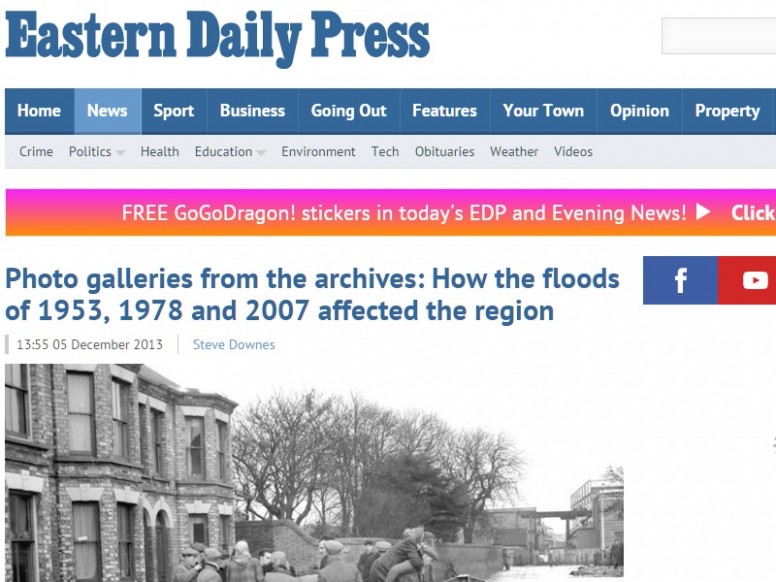Storm Event
Predictions of a large North Sea storm surge result in closure of the Thames and Rotterdam Flood Barriers
Source
The storm developed along the eastern US seaboard on 5th November 2007, and the low-pressure system moved across the Atlantic from Iceland towards southern Norway during 8th-9th November. While passing over northern Scotland on 8th November 2007, the central low pressure was 971 mbar at 1200 UTC (Parker and Foden, 2009). The steep pressure gradient generated severe gale force winds in northern Scotland with peak gusts of 82 knots [42 m/s] at Fair Isle (Eden, 2008; Horsburgh et al. 2008). The winds over the North Sea were of a north to northwesterly orientation with maximum speeds of 49 to 52 knots [25 to 27 m/s] (Parker and Foden, 2009).
The storm generated a skew surge in excess of 1 m at 4 sites on the east coast of England. Water levels exceeded the 1 in 5 year return period at only one site: Lowestoft, where the high water on 9th November 2007 was of a return period of 1 in 19 years. The largest skew surge (1.56 m) was also at Lowestoft. Other reports also note skew surge values of above 1.5 m in the North Sea (Idier et al. 2012), which decreased as the surge reached the English Channel. The skew surge at Newhaven was in the range of 0.5 to 0.75 m.
Wave heights in Walcott, Norfolk reached 12 ft. [3.7 m]. We are unaware of any further sources describing the wave conditions during this event.
Pathway
Most defences along the east coast experienced overtopping with some minor breaches.
Receptor and Consequence
This surge event, combined with high tides and strong winds had created fears of coastal flooding with the most threatening storm surge on the east coast in 50 years (BBC, 2007a; Flowerdew et al. 2010). Worst case predictions were that the flood would be similar to 1953 (Institute of Civil Engineers, 2014). The sea level at Lowestoft was 0.71 m above the Environment Agency Alert Level (Met Office, 2011). In London, the Thames Barrier, and the Queensborough and Dartford Creek barriers were closed on 8th November (BBC, 2007b; Institute of Civil Engineers, 2014; William, 2007). No loss of life occurred but property was damaged (Met Office, 2011). In Norfolk, some defences experienced minor breaches and some coastal roads were flooded (Moore et al. 2007). Residents of care homes and hospitals were evacuated by Norfolk Police, Norfolk County Council, and Great Yarmouth Borough Council (BBC, 2007b). Walcott, a coastal village in Norfolk, was among the worst affected areas where large waves breached the sea wall and damaged conservatories and holiday housing, also displacing caravans and boats across the coastal road (Williams, 2007). 30 people were rescued from sheltered accommodation in Lowerstoft, Suffolk by fire crews in dinghies (Williams, 2007). Felixstowe docks were closed, and rail services were suspended between Lowestoft and Norwich due to flooding (BBC, 2007a). Costs of £170,000 to the Norfolk County Council were estimated, and upward of £53,000 to the Great Yarmouth Borough Council (although overall the performance of coastal defences was a success) (Ellis, 2008). Some erosion damage to natural defences was reported e.g. sand dunes at Hemsby, Scratby, and Winterton-on-Sea (Ellis, 2008).
Summary Table
| Loss of life | * |
| Residential property | * |
| Evacuation & rescue | Norfolk police visited residents in 7,500 homes in Great Yarmouth and advised them to leave. 30 people were rescued from sheltered accommodation in Lowerstoft, Suffolk by fire crews in Dinghies |
| Cost | Norfolk County Council incurred estimated damages of £170,000, and upwards of £53,000 in damages to Great Yarmouth Borough Council |
| Ports | Felixstowe docks were closed |
| Transport | * |
| Energy | * |
| Public services | * |
| Water & wastewater | * |
| Livestock | * |
| Agricultural land | * |
| Coastal erosion | * |
| Natural environment | Several important coastal bird feeding grounds in England were flooded |
| Cultural heritage | * |
| Coastal defences | * |
*No known sources of information available
Affected Sites
| Name | Return Period ? | Water Level ? | Tide ? | Skew Surge ? | Date ? |
|---|---|---|---|---|---|
| LOWESTOFT | 19 | 4.13 | 2.55 | 1.57 | 9th Nov 2007 08:15 |
We rely on submissions from the public to maintain these images. If you witnessed this event, please help by uploading your photos.
References
- Parker, J.A. and Foden, D. (2009). ‘High-resolution Measurement of a North Sea Storm Surge’. Journal of Coastal Research, 56, pp.1656–1660. Available at: http://e-geo.fcsh.unl.pt/ICS2009/_docs/ICS2009_Volume_II/1656.1660_J.A.Parker_ICS2009.pdf
- Eden, P. (2008). Great British Weather Disasters. London: Continuum UK.
- Horsburgh, K.J. et al. (2008). ‘Aspects of operational forecast model skill during an extreme storm surge event’. Journal of Flood Risk Management, 1(4), pp.213–221. Available at: http://doi.wiley.com/10.1111/j.1753-318X.2008.00020.x (Accessed: 6 April 2015).
- Idier, D., Dumas, F. and Muller, H. (2012). ‘Tide-surge interaction in the English Channel’. Natural Hazards and Earth System Science, 12, pp.3709–3718
- BBC, (2007a). ‘Thousands go home after tide fear’. BBC News. Available at: http://news.bbc.co.uk/1/hi/7086280.stm (Accessed: 11 November 2015).
- Flowerdew, J., Horsburgh, K., Wilson, C., Mylne, K. (2010). ‘Development and evaluation of an ensemble forecasting system for coastal storm surges’. Quarterly Journal of the Royal Meteorological Society, 136(651), pp.1444–1456
- Institute of Civil Engineers, (2014). Case studies: Coastal surge November 2007 – combating the threat of flooding. Available at: http://www.ice.org.uk/topics/maritime/Case-studies-marine-engineering/Combating-coastal-flooding
- Met Office, (2011). ‘Storm surge — November 2007’. Met Office. Available at: http://www.metoffice.gov.uk/about-us/who/how/case-studies/floods-2007 (Accessed: 11 November 2015).
- BBC, (2007b). ‘Tidal surge poses grave danger’. BBC News. Available at: http://news.bbc.co.uk/1/hi/england/7085394.stm (Accessed: 11 November 2007)
- Williams, R. (2007). ‘US Relief after East Anglian coast emerges from storm surge’. The Guardian. Available at: http://www.theguardian.com/uk/2007/nov/10/weather.immigrationpolicy
- Moore, M., Clout, L. and Alleyne, R. (2007). ‘Tidal surge hits the coast of East Anglia’. The Telegraph. Available at: http://www.telegraph.co.uk/news/uknews/1568827/Tidal-surge-hits-the-coast-of-East-Anglia.html (Accessed: 11 November 2015).
- Williams, R. (2007). ‘US Relief after East Anglian coast emerges from storm surge’. The Guardian. Available at: http://www.theguardian.com/uk/2007/nov/10/weather.immigrationpolicy.
- Ellis, J. (2008). Report to Fire and Community Protection Review Panel Norfolk North Sea High Tide and Surge event 8 / 9 November 2007 North Sea High Tide and Sea Surge Event 8 and 9 November 2007, Available at: http://www.norfolk.gov.uk/consumption/groups/public/documents/committee_report/firecom200508item15pdf.pdf


